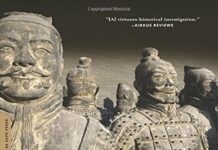
Ebook Info
- Published: 2014
- Number of pages: 336 pages
- Format: PDF
- File Size: 5.24 MB
- Authors: John Man
Description
The definitive history of the ninja, based on a wealth of historical texts, local Japanese sources, and John Man’s own treks across Asia“An immensely entertaining history, packed with splendidly blood-thirsty tales of derring-do, feats of endurance and self-sacrifice.” ―The GuardianOut of the violent chaos of medieval Japan, a remarkable band of peasants rose to become the world’s most feared warriors―trained to perfect the art of ninjutsu, the deadly union of martial arts and deception. Today, however, these real life ninjas are overshadowed by legend and pop culture caricatures. Could they fly? Climb walls? Make themselves invisible?Drawing on a wealth of historical texts, local Japanese sources, and his own comprehensive treks across Asia, acclaimed author John Man takes us back to the ninjas’ origins in China, through to their heyday in the bloody civil wars that ended with the unification of Japan in 1600. Man also illuminates the twentieth-century reemergence of the Japanese tradition of shadow warfare through the Nakano Spy School―the elite military-intelligence academy that operated as an extensive spy network during World War II―and reveals one former Nakano soldier, Onoda Hiroo, who may be the last surviving ninja.Compelling and absorbing, Ninja reveals at last the fascinating true history behind one of the world’s most enduring legends.
User’s Reviews
Editorial Reviews: Review “An immensely entertaining history, packed with splendidly blood-thirsty tales of derring-do, feats of endurance and self-sacrifice.” — The Guardian“Ninja is a racy popular history of a difficult and often mythologised subject and should appeal to the armchair warrior in us all.” — Literary Review“One could ask for no better storyteller than John Man.” — Simon Sebag Montefiore, author of Jerusalem: The Biography“An intriguing look at the enigmatic world of the deadly Asian assassin. … Fascinating. … A thoroughly researched, appealing examination of the original ‘men in black.’” — Kirkus Reviews“As colorful and intriguing as the warriors it so vividly brings to life.” — Bookreporter.com From the Back Cover Out of the violent chaos of medieval Japan, a remarkable band of peasants rose to become the world’s most feared warriors—trained to perfect the art of ninjutsu, the deadly union of martial arts and deception. Today, however, these real life ninjas are overshadowed by legend and pop culture caricatures. Could they fly? Climb walls? Make themselves invisible?Drawing on a wealth of historical texts, local Japanese sources, and his own comprehensive treks across Asia, acclaimed author John Man takes us back to the ninjas’ origins in China, through to their heyday in the bloody civil wars that ended with the unification of Japan in 1600. Man also illuminates the twentieth-century reemergence of the Japanese tradition of shadow warfare through the Nakano Spy School—the elite military-intelligence academy that operated as an extensive spy network during World War II—and reveals one former Nakano soldier, Onoda Hiroo, who may be the last surviving ninja.Compelling and absorbing, Ninja reveals at last the fascinating true history behind one of the world’s most enduring legends. About the Author John Man is the author of Attila, Genghis Khan, The Great Wall, Gobi: Tracking the Desert, Ninja, Samurai, and other works. Educated at Oxford and the University of London’s School of Oriental and African Studies, he was awarded Mongolia’s Friendship Medal in 2007. Read more
Reviews from Amazon users which were colected at the time this book was published on the website:
⭐The book was as advertised and arrived undamaged, expertly packaged against handling damage.
⭐The author, John Man, isn’t the first historian to fall for the siren call of ninja history only to plummet into a catch-22, but he’s the one I’m reviewing right now. So, while his book isn’t exceptionally bad, it’s tremendously flawed in a manner common across ninja histories. What is said catch-22? On the one hand, ninja excite the imagination and a half-way decent book on them is sure to sell. On the other hand, there’s very little known about the ninja. If the myth of the ninja is an elephant, the ninja as we truly know him is a grasshopper. [So much so that the first Westerner to write such a history, Stephen Turnbull, has now spun 180, proposing that the ninja never existed but were purely a post-Warring States construct.] While it would seem that Turnbull goes too far given the existence of manuals and vague mentions, what we don’t know about are the nitty gritty details of ninja missions and those are the stories that the reader desires but which time and the ninja’s legendary secrecy have put forever beyond our reach.What is in the book? If not tales of ninja stealing into castles to abscond with information or to assassinate an enemy General, and the effect of those actions on the outcome of wars? First, there’s a lot of information that is already widely available in other English language books, such as the influence of Sun Tzu’s chapter on espionage on the birth of the ninja (probably spurious given the centuries in between) and description of the seven types of disguises. Second, there’s a lot of general Japanese history that is necessary to some degree as background, but at some point one realizes the author has ventured beyond background into padding. Finally, speaking of padding, about a third of the book by page count (cleverly disguised as only three chapters) occurs long after the end of the ninja. Don’t get me wrong; some of the World War II material is fascinating, but it’s as if one were reading a biography of Blackbeard and—all of a sudden—one finds oneself reading about a Somali hijacking of container ships in 2011. (Even while you are fascinated, you can’t help but feel that you’ve been the victim of bait-and-switch.) In short, the book has a lot of repetition and padding, and not much that’s both new and on topic. (One of the reasons that I didn’t give the book too low a rating is that if it’s the first book you are reading on the subject, it’s readable and interesting.)There’s one more flaw that comes from the dearth of information. The author cites everyone and anyone who has said something interesting on the subject, but we don’t really know how reputable said sources are. Some may be sterling and others full-of-shit. It’s easy to say something fascinating about the ninja; it’s much more difficult to say something that’s true and fascinating.So what does the book do right? It’s well written in terms of being readable and offering frequent mind candy. The author does challenge a few statements as he reports them. My last paragraph may have led one to believe that Man just shot-gunned information out there, but he actually takes a suitably skeptical view for addressing such a murky topic. The problem is that we don’t know how serious to take claims he refutes or those he appears to endorse because he’s not an expert in the field. He is an Asianist historian with a list of books that is all over the map. [I did see just one factual error in which he refers to the companion sword of a samurai as a tanto. A tanto is a dagger, the companion to the katana is the wakizashi. But I don’t know how big of a deal to make out of that sin as I can’t say that I noticed any others (not that I necessarily would as I’m no expert either.) On the other hand, a little fact checking…]If you’ve never read a history of the ninja before, you’ll probably find this one interesting. If you’ve read the other books out there, it’s less clear that you will. However, I did find the discussion of Iga no Ran (the battle of Iga, a campaign meant to crush the ninja of Iga) to be intriguing. At any rate, as long as you realize the last one-third of the book is off-theme and are alright with that, you should find it palatable.
⭐Over the years I have read numerous books on Japanese history. I have had a lifetime interest in the martial arts (Judo, Jujitsu, Karate-Do, Kenjutsu, Kendo, and Ninjutsu) and I recently purchased this very interesting and informative (288 pages) hardcover book (Ninja: 1,000 years of the Shadow warrior: a new history by John Man). Even though I was somewhat familiar with many of the details of the Japanese Ninja, this wonderful book had information about the Ninja warriors that I had not read in the previous volumes. In the beginning section there is a map of Japan showing the areas in which the Ninja operated.There is an enormous amount of material for anyone doing research into the history of the Ninja in Japan. The following material is covered in this enlightening book: Origins, how to be a shadow warrior part 1, mind and spirit, Anti-ninja: the Samurai, how to be a shadow warrior part 2, deception and charm, a world of violence and undercover Ops, how to be a shadow warrior part 3, magic, building the Ninja heartland, the rise of the conqueror, the calm before the storm, the end of the old ninjas, Nobunaga’s end, Leyasu’s rise, the final battles, shadows in retreat, the Nakano spy school, to Japan with love and the last of the ninjas.If you are interested in the history of Japan and the role the Ninja played in its development and demise this book is for you. A fantastic read.Rating: 5 Stars. Joseph J. Truncale (Author: Shotokan Karate: Practical combat karate for the street).
⭐I have read most of John Man’s books, and thoroughly enjoyed them. As a historian, he knows how to do his research, as a travel writer, he knows how to make the places come alive on the page. If you’re looking for a text book, go to another book. If you’re looking for some interesting history and tidbits on Japan and the Ninja, this is the book for you.There are footnotes scattered throughout. They are real footnotes at the bottom, or foot, of the page, not the abomination sweeping the publishing world called endnotes where you may or may not find them at the end of the chapter or book.My biggest take away from the book was the difference between Ninja and Samurai. Ninja (who, by the way, preferred dark blue rather than black clothing) had the idea it was better to live and fight another day. Samurai prefer an honorable death at any cost.Why, you may ask, did the Ninja prefer dark blue to black? It blends in with shadows better on a bright moonlight night. And most Ninja were farmers, and most farmers wore dark (indigo) blue clothing.A lot of questions I had, some I hadn’t realized I had, were answered in this easily read and very enjoyable book. Remember, this is not a textbook filled with dates and names and dry facts. Man is a travel writer, who is also a historian, and combines the two well. This book is a nice trip to Japan–both past and present and highly recommended.
⭐I had hoped for a history of ninjitsu. This is more of a personal travelogue. I was disappointed.
⭐Objective look at the real ninjas and not romanticizing the myth. Alot of really good information. I felt it was a little long and could almost be described as a book on military history as opposed to a book dealing strictly with ninjas. Also, at the end I feel like the author is just filling pages to beef up the book. All the chapters on covert operations in WW2 really are stretching the ninja connection. His section on his research into wilderness survival doesn’t have anything to do with ninjas. Also, for those interested in the possible secret mission of 2Lt. Onoda read ‘Golden Warriors’
⭐Apparently John Man doesn’t speak Japanese, although he does have some of the Far Eastern languages. This is perhaps why this book felt stilted (to me). I felt I was constantly awaiting a revelation which never came. There is some interesting material on Ninjas. And some interesting history about the Shogun period of Japanese history. But somehow the Ninjas were never central to events.His Ghenghis Khan is fab.
⭐An informative easy read. Not perhaps as good as some of the author’s other works as the focus of the work is not as sharp.
⭐A knowledgeable and sympathetic work by an author who has gone to great lengths to discover what he knows:and freely share it.
⭐Macht Spass. Wir waren gerade in Japan bei dem im Buch beschriebenen Ninja-Guru (Enkel) und meine Kinder waren begeistert. Das buch ist lesenswert, wenn man sich für diese Thematik interessiert.Delivery fast, condition perfekt.The Book itself: very interesting and showing a new perspektive from what I have known from the Ninja way of life.Very good investigated informations and a good read for the Weekends.
Keywords
Free Download Ninja: 1,000 Years of the Shadow Warrior (P.S.) in PDF format
Ninja: 1,000 Years of the Shadow Warrior (P.S.) PDF Free Download
Download Ninja: 1,000 Years of the Shadow Warrior (P.S.) 2014 PDF Free
Ninja: 1,000 Years of the Shadow Warrior (P.S.) 2014 PDF Free Download
Download Ninja: 1,000 Years of the Shadow Warrior (P.S.) PDF
Free Download Ebook Ninja: 1,000 Years of the Shadow Warrior (P.S.)





